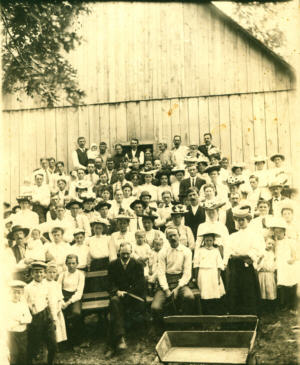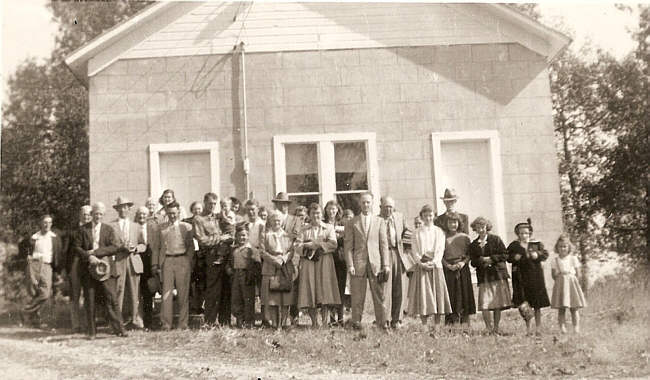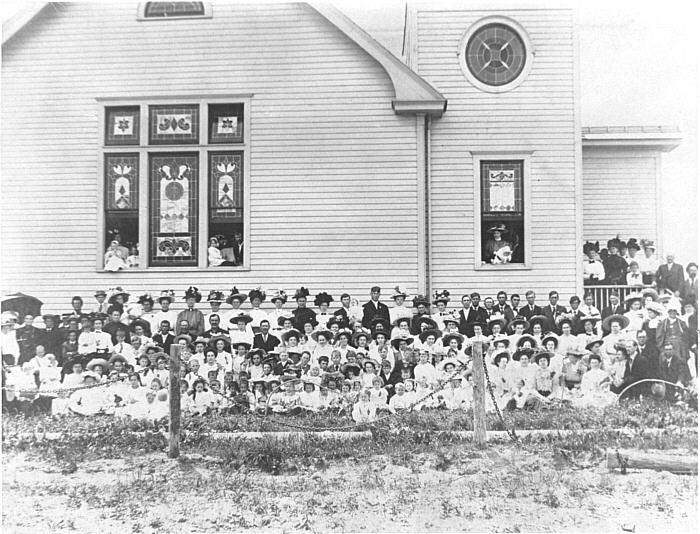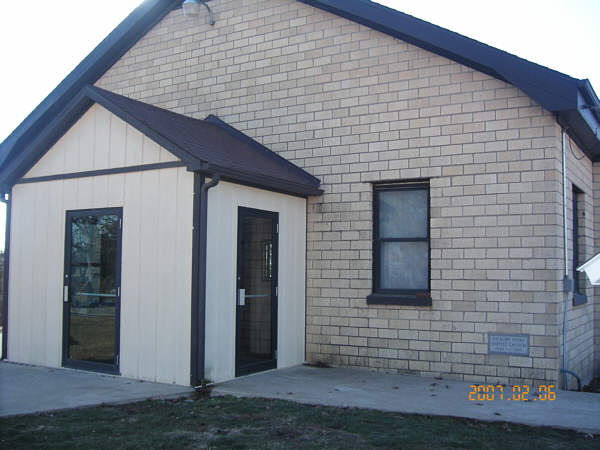
Churches of Miller CountyTHE BAPTIST CHURCH
|
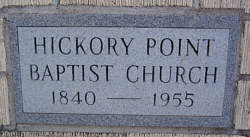 |
During April of 1842, when Hickory Point Baptist Church was two years old, members raised 75 cents to help pay the expense of the Cole County Association at Mt. Gilead. This could very well be the first missionary offering from Miller County. In 1843, 27 new members were added to the congregation, two of which were black sisters and another black sister was added later. In May of 1843 a petition was made by one member to extend an arm of the church to the Glaize. The petition was granted, and became a mission point. This could well be the beginning of the Brumley Church, for many members from that community received letters of dismissal, with the minutes not stating where they went. In 1847 the church voted to observe the ordinance of foot washing, it is not know how long this was practiced.
During the year of 1849 the Alexander Campbell Reformers came and the church suffered a significant split. The records indicate that about one third of the member' names are marked "excluded" and those remaining are marked "transferred", which could mean they started all over. There are also many names marked "excluded" through the years for various reasons of unchristian conduct such as profane swearing, dancing, getting drunk, contempt of church, non-attendance, horse racing and fighting.
The only time the church has ever been closed for more than one month was from April 1864 to August 1865. Minutes state that all male members were in the United States service.
During February 1949 a building fund for a new house of worship was started, and during a revival in April 1955 walls were poured for the basement. By late fall the old building was torn down. During the construction period the church met in the old Watkins store owned by Ross Livingston. The first services in the new church house were conducted the Sunday before Christmas of 1955. In November 1976 work started on a basement for a parsonage and the house was completed during April of 1977. In 1983 thirteen new classrooms were added to the west end of the church.
Pastors serving the Hickory Point Baptist Church over the years are:
Ruben Short (to care of church), (1840), G.O. Morris (1841), J. Brockman (1846), Z.W. McCubbins (1846), William McCubbins (1850), Z.W. McCubbins (1853), William McCubbins (1854), Ruben Short (1862), G.O. Morris (1864), Jacob McCombs (1865), H. Odon (1869), Owen Burks (1870), Jacob McCombs (1871), William Payne (1872), Benjimine Castleman (1874), Matthews (1874), Jacob McCombs (1874), Henery Odon (1876), Owen Burks (1877), J.M. Hibbs (1882), W.H. Payne (1883), Lewis Castleman (1885), William Payne (1888), I.A. Jordon (1891), W.E. Sears (1892), R.B. Carnett (1895), H.B. Carnett (1895-1905), Tom Carnett (1905-1907), J.M. Bandy (1908-1915), R.B. Carnett (1915-1924), W.L. Houser (1924-1926), H.L. Gillenwaters (1926-1928), Harry Zumwalt (1928-1942), Lester Gibheart (1942-1943), Johnie Schnider (1943-1945), Freddie Lewman (1945-1946), Bill Scrivner (1946-1947), Clyde Faulkner (19471948), Clyde Riddle (1948-( 1949), Neil Terwilliger (1949-1953), Charles Cox (1954-1958), Delbert Ketner (1971-1972), Sam AlIens (1972-1976), Elmo Terry (1976-1977), Dave Judson (1977-1980), Clinton Stockton (1980-1981), Jack Simon (1982-1984), J. Barry Pennington (1985-1988) and Larry Etherton (1988-).
HONEY SPRINGS BAPTIST CHURCH
Bill Pritchett saw the need for a Baptist Church in the area, so F.B. Smith, Miller County Missionary, was contacted and plans began. The first meeting was held in the old Number 70 School building in 1962. The new mission was sponsored by the First Baptist Church of Iberia. In October of 1962, ground was purchased for a building site and work began on a 30' by 60' basement. The mission began meeting in the new structure in 1963.
On November 10, 1968, the mission was organized as the Honey Springs Baptist Church, with the help of C. Roberson. Charter members of the church were: W.C. Pritchett, Gladys Pritchett, Rose Pritchett, James Pritchett, W.E. Pritchett, Janet Pritchett, Helen Nichols, Layman Duncan, Sarah Duncan, Elmer Karr, Gladys Karr, Lenard Russell, Lou Russell, Jess Pritchett, Shirley Pritchett, Judy Robinett, Emerson Allee and Myra Allee.
A new auditorium was finished May 21, 1972. Honey Springs had the first deaf ministry in the state of Missouri in 1976, with seven enrolled in the ministry. Pastors who served the mission were: Jess Stone, Marvin Davis, C.R. Morgan, Enloe, and Frank Shuler.
Pastors who have served Honey Springs Baptist Church include:
Charles Caldwell 13 years), Bill Larsen (1982-1983), Glen Stenhouse (1983-1984), Willis Horton (1985-1988), Arthur Gormley (1988-1992), and Herb Mathews (1992-).
Rex Freeman is currently the pastor and Nina Wilson is Sunday school Director.
FIRST BAPTIST CHURCH OF IBERIA
The Iberia First Baptist Church was organized in 1843 as the Big Richwood Baptist Church of Christ. At the time of organization there was no building available except a small log house known as Smyrna Church. The log house was also used by other churches in the community and served as a school house for a couple months during the year. Before the Civil War, the First Baptist Church held revivals in brush arbors or in homes.
In the years preceding the Civil War, dissension arose among the different denominations using the old Smyrna Church. As a result, the Baptists decided to erect a building of their own. In March 1858 a small tract of land was purchased from Mr. and Mrs. Samuel Tucker, which is now part of the Iberia Cemetery. The church house that was erected on the new site was also of hewn logs. The congregation was known locally as the Sulky Baptist Church. The church remained at this location until May 1885 when it was decided to move into town and build a new building. The erection of the building was begun at once and, since very little money was available, the majority of the work was done by donation. The new building stood on the site where the Nazarene Church now stands and was completed in 1886.
Articles of Incorporation were granted the church on August 22, 1888. Shortly after the church was incorporated, the town was incorporated under the Village Law and named Iberia. The church, in keeping with the village incorporation, changed its name from Big Richwood to First Baptist Church of Iberia on October 5, 1889.
In June of 1950 the church again decided to go into a building program to remodel the old church house and add an educational wing. The building was completely remodeled inside and out, including the installing of the memorial windows, and was dedicated on November 9, 1952.
In 1977 the church purchased land on Highway 17 north of Iberia. On November 22, 1977, a ground-breaking was held to build a new parsonage on the new site. In 1984 the church voted to begin a new construction fund for the purpose of building a new worship center. By early 1987 the construction fund had reached $75,000.00 so a building committee was selected for the construction of the church.
The ground breaking for the new building was held on Sunday afternoon in July of 1988. The new building was started in late July. The Church was blessed to have a group of 20 men from Eastmont Baptist Church, Montgomery, Alabama, who call themselves "Carpenters for Christ." The men took a week vacation and paid their own way to help build the church. It was estimated that they contributed $50,000.00 in labor. Much of the additional work was done by volunteer labor from church members and friends under the supervision of Charles Prater.
The Sunday school was able to move into the education wing of the new building on February 5, 1989, and on Father's day 1989 the first service was held in the new sanctuary. The Dedication Service was held on Sunday, September 17, 1989. A dinner was served at noon with several of the former pastors in attendance.
On October 28, 1989, an auction was held to dispose of all fixtures and furnishings from the old building that were not needed in the new building. On January 7, 1990, the First Baptist Church and Church of the Nazarene held a joint service at which time First Baptist gave the site of the old building to the Church of the Nazarene as it joined their property. Shortly after the old property was turned over to the Church of the Nazarene and while in the process of being torn down, fire completely destroyed the old building.
First Baptist Church of Iberia has had the privilege of helping establish two missions. The first, known now as Honey Springs Baptist Church, was established in November 1963 and the St. Elizabeth Baptist Fellowship was established in October 1990.
The current pastor is Rev. Glen Golden.
MOUNT CARMEL BAPTIST CHURCH
By Tammy Witherspoon
On Oct. 31, 1904, the congregation of the Mt. Carmel Baptist Church of Christ met for the first time at 12 p.m. The building site for the church was donated by Lawson Thacker and D.F. Slavens. Ten people came forward and offered themselves as charter members of the church. They were: Rev. J.M Henderson, Lawson Thacker, Alice Pruitt, Nancy Pountain, Harriette Lowery, Mrs. H.J. Henderson, Henry Jenkins, Mary Jenkins, E.M. Stark and Sarrah Brown.
The church has seen its share of changes throughout the years. In a business meeting in 1920, the church declared dancing and card playing to be a public offense to the church and the cause of Christ. Any member allowing either offense to be carried on in their home or engaging in either offense was to be dealt with as a public offender.
March 25, 1922, which was Easter Sunday, was declared "Egg Day". Proceeds from eggs gathered were given to the home for aged Baptist. Looking at the books from 1938 will show the fortunes of the church improving. They had enough money to be able to employ a janitor at a salary of two dollars a month.
On January 23, 1943 Mt. Carmel voted to build a basement and move the church building to the spot where it is now located. $3000.00 was borrowed from the Bank of Eldon to complete the building and for redecoration. A well will drilled in 1958 and a pump installed for water in the church. A serving counter was added to the kitchen the next year. A note burning was conducted on November 5, 1960, making the church building debt free.
On October 27, 1998 six members and the pastor met at the church to discuss closing the church doors and dispense with the church corporation. The reason for this was there were only seven or eight people who regularly attended the church. The members who attended the meeting expressed the desire to give the church property to the Miller County Baptist Association.
On Sunday, January 10, 1999, a last dissolution service was held at the church. The Reverend Louis Elseman led the service. Doris acted as song leader with Wilma Admire as pianist. Joe Wood led a prayer and Curtis Beach gave a history of the church and made a presentation of the church property to the Baptist Association.
Mt. Carmel Baptist Church pastors:
J.M. Henderson (1904-1906), John Mahan (1906-1907), J.H. Baughman (1907-1908), John Mahan (1908-1909), W.L. Houser (1909-1910), J.M. Henderson (1910-1914), E. Thacker, (1915-), John Mahan (1915-1916), E. Thacker (1916-), S.P Cox (1917-1919), J.M. Henderson (1919-1921), Charles Hedrick (1922-1925), J.M. Henderson (1926-1927), David Vaughn 1928-), W.E. Connor 1929-1930), R.A. Wood 1931-1933), W.L. Howser (1934-1935), David Vaughn (1936-1938), G.O. Hickey 1939-), W.L. Houser (1940-1941), Will Williams 1942-), Chester Lindsey (1942-1943), Wm. Boleck (1943-1944), Ralph Blair (1944-1945), Luther McReynolds (1946-), E.L. Painter (1946-1948), C.E. Young (1948-1949), Frank Smith (1508-1952), Neil Terwilliger (1952-1957), J.V. Roberts (1957-1960), L.E. Johnson (1960-1966), Louis EIseman (1966-1971), Charles Foley (1971-1972, James McDonold (1972-1976), C.R. Morgan (1976-1981), Delbert Admire (1982-1983), George Cox (1983-1991), Louis EIseman (1991-1999).
MOUNT HERMAN BAPTIST CHURCH
On December 12, 1872, a group met at the Mt. Herman School House and organized the Mt. Herman Baptist Church. The group elected B.I. Berkley as the first pastor. The church was to meet on the first Saturday of each month. Mt. Herman became a member of the Miller County association in 1892. Prior to that time the church was a member of the Concord Association.
Early church records do not mention the names of the charter members. However, the following are the names of the congregation taken from very early minutes of the church and it is assumed that the list names several of the charter members. The members listed are: John Jordon, W.M. Robertson, B.I. Berkley, Sam Hunsaker, J.C. Smith, John VanHoosier, Susan VanHoosier, Robert Hix, Ellen Hix, Susan Jordon, Nathaniel Wyrick, Sarah Hunsaker, Elizabeth Wyrick, C. Stofel, W.J. Vernon, Elizabeth Hix, Kathy Shadwick and Adaline Vernon.
In July of 1873, a committee was chosen to select a site for the church building. A committee was also chosen to solicit funds for the building. Soon the committee reported there was $233.90 in the Building Fund. A motion was made to build a church house 32 feet wide, 50 feet long and 12 feet high. The site committee reported on a location on the John Long place "at or near the fork in the road". A deed and abstract dated February 17, 1874 shows that one and one half acres (more or less) was purchased from John and Nancy Long at a cost of $10.00. Jesse Teren donated sufficient lumber to frame the building. It is not recorded in the minutes as to when the building was completed.
Over the years many members of Mt. Herman Baptist Church have been called to full-time Christian service. The minutes indicate that the following were ordained to the ministry by Mt. Herman: H.V. Nelson (1932), Lindley Enloe (1942), Jack Bordon (1948), and Jack Sanders (1958).
Many interesting things have happened throughout the history of Mt. Herman. Minutes indicate that in 1884 the church employed Henry Van Hooser to clean, furnish water and wood for the church for $1.70 per year.
It is reported that in 1890 "there was much unrest during this time and many members were joining the Camelites". Exclusions for members having Play Parties and Dances, Larceny, Fornication, Heresy and language unbecoming of God's children was common.
In 1929 a committee was appointed to see after the members that were "walking disorderly". The church adopted the following resolution: "Whereas there has been unbecoming conduct in the church-be it resolved that here-after we will prosecute to the extent of the law any or all persons guilty of creating a church disturbance in any manner whatsoever in or near the church".
The church building was used by the school in 1935 after the school building burned. The school was responsible for cleaning the church. During the canning season that year the Ladies Aid canned food for the Old Folks Home.
After parents had been visited to get their approval the year before, Vacation Bible School was held for the first time in 1945. The school had an average attendance of 19. The next year the school had an average attendance of 43. The church went to half time the same year.
In 1903 a special meeting was held to consider building a new church house. It was decided to build on the same site and by a vote of 12-5 it was decided to build the new church the same size as the old and use all the good material from the old. In 1904 the church decided to build a cement building but this was again reversed when it was voted in 1906 to rescind all former action in regard to building and the building treasurer was instructed to pay back all money given for the building. Finally after much changing and voting, the church voted to build on the old site. The new church building was built and was dedicated in 1906.
In 1958 it was voted to build a basement and move the church building onto it. The basement was dedicated in September.
In 1984 a twelve by forty foot addition was built to the West side of the church building consisting of two classrooms, a pastor's study and storage room with classrooms below.
Mt. Herman records indicate that the following pastors served the chruch over the years:
B.J. Berkley (1873), Nathaniel Wyrick (1877), R.C. White (1880), W.D. Jordon (1883), J.D. Watson (1888), John Maxey (1889), Jehew Robinson (1890), Nathaniel Wyrick (1892), J.H. Roddy (1894),David McCombs (1895-1900), W.D. Scrivner (19021903), J.L. Moon (1905), John Calwell (1905), Tommie Cornett (1907), J.A. Calwell (1907" D. McCombs (1908), Hensley (1909), Henderson (1911), Hensley (1911-1912), Birge (1918), Elmer Thacker (1920-1922), Charley Hedrick (1923), Alvie Stark (1924-1925), Charlie Hedrick (1926), Robert Wood (1928), G.B. Case (1930-1936), D.F. Vaughn (1937), James Lamb (1938-1940), Harry Zumwalt (1940), Alvie Starks (1940), J.W. Brewer (1942), Lindley Enloe (1945), J.W. Hackney (1947-1948), Jack Borden (1948-1949), Lindley Enloe (19491951), Fred Crigler (1951), C.R. Morgan (1952-1957), Jack Sanders (1959), Selby Graham (1959-1970), Louis EIsman (1971-1976, James McDonald (1976-1982), Lloyd Patterson (1982-1983), Ed Teal (19831985), Lloyd Patterson (1985-1986), Jim McDonald (1986), Louis EIsman (1987), Danny McNeal (1988-1989), Don Deauxion (1989), H.J. Quinn (1989-).
OLEAN BAPTIST CHURCH
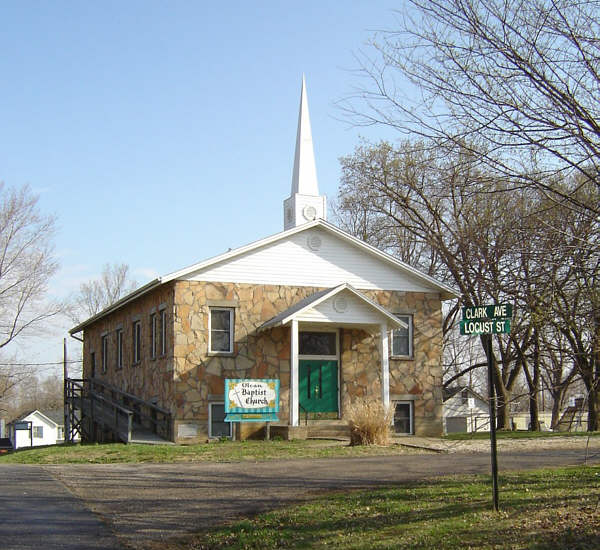
The missionary Baptists of Olean met on Saturday evening, April 21, 1894 to organize a Baptist Church in Olean. The council consisted of Brethren from Clarksburg, Rock Enon, Greenridge, Mt. Herman, Spring Garden and High Point. Elder J.T. Baker, Missionary of the Concord Association, announced the purpose of the meeting and was chosen chairman. Elder W.L. Cornett preached the sermon, his text being 1 Peter 2:2 and Ephesians 3:21. The theme was "The Church of Christ and its development". Charter members, (members of other Baptist Churches) being, Mrs. Missouri Gilleland, Mrs. Victoria Currence, Addison Walser, Thomas Starling, Dora Starling, Kittie Mode, Mary J. Skelton, L.R. Campbell, Mary E. Roark, William Mosher, Nettie Moser, Mollie McCann and Harriet Campbell. Those from Greenridge who helped organize the Church were R.L. Hood, Pastor Lemuel Agee, B.D. Roark, and William Roark, Deacons. Names from the other churches are not known as records were not available until 1898.
The original church building was a hexagon shaped wooden building with one room, seating about 250 people. Classrooms were made by using a system of wires and curtains. Electricity was added to the building in 1928.
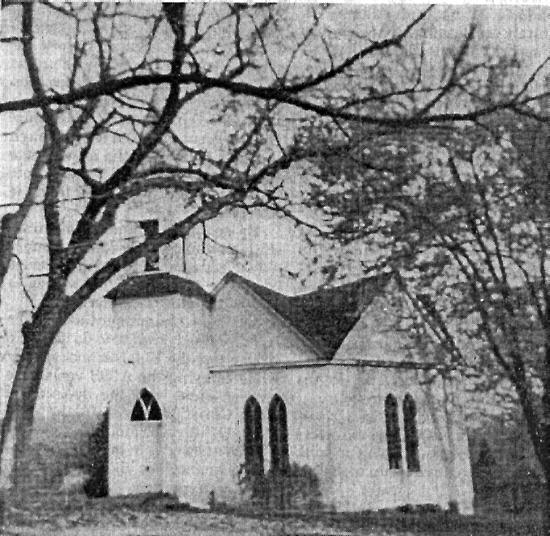
On July 2, 1907 the church voted to ask Concord Association for a letter of dismissal so the church could unite with the Miller County Association. The letter was granted and Olean Baptist Church joined the Miller County Baptist Association. The first delegates to the association were L.F. Agee, W.H. Burris, J.C. McSpadden, R.G. Atkins and D.B. Taylor.
The first mention of a woman's organization was 1912 when mention was made of Ladies aid. The Women's Missionary Society was formed in April 1927, with Mrs. Earl Wiser President.
The church went to full time preaching in 1946. Before that services were held twice a month and sometimes only once a month.
Brother Arnim Ray's first pastorate was at Olean Baptist Church and he was also ordained by the church. Glen Walker was the first person he baptized and Roy Lane was the second.
On March 24, 1948, under the leadership of Ernest Waite the church voted to enter into a building program. Naomi Walker Cain donated 1 1/2 lots for the new building. A building committee was appointed consisting of J.A. McMillan, Chairman, Heaton Haynes, and Roy Lane. A finance committee was also appointed with Royce Rebstock, Chairman, along with Glen Walker, Howard Arney, Clarence Herquith, Anna Hahn Stella Haynes and Brooks Miller.
The new (present) church was built of sandstone hauled from the Willard Kelsey farm in the Hickory Point community. Glen Knoch was in charge of construction aided by several volunteers. Dedication was held June 27, 1948 and the debt was paid in 26 months. Over the years the Baptistry, bathrooms, water and other improvements have been added, some purchased by the Church and some donated as memorials. The latest addition is the handicap ramp which was built by Mark Barry with some assistance from the men of the church and community.
On September 1, Alton Hendricks was approached by Julian Crane asking about donating the bell from the old church to South Africa. Sam Upton, from the Aurora Springs Church serving in Malawi, wrote telling of the need. People there had no watches or clocks, so the bell was needed to call people to worship. The Church voted to send the bell and did so at a cost of $186.00. Hopefully the bell still rings and sends out a call for all to come and worship the Lord.
On November 7, 1973 Robert Barry suggested a Community Thanksgiving service. Brother Ray, Interim Pastor at the time, contacted the Pastors of the Olean Christian Church, Greenridge Baptist Church and Mt. Herman Baptist Church. The service was held at the Christian Church with a full house in attendance. This tradition continues today, with the inclusion of Mt. Pleasant Christian Church, and always has a capacity crowd.
In May of 1969 the Church held a 75th Anniversary Celebration and in July of 1988 a re-dedication service was held to commemorate the 40th Anniversary of the present Church. On June 26, 1994 Olean Baptist Church held the One Hundredth Anniversary of the organizing of the Church.
Pastors who have served over the years include:
W.T. Tate (1898), Jehr Robinson (1899), J.G. Barker (1900-1902), W.A. Bruce (1903-1906), J.D. Watson (1907), W.W. Brown (1908-1909), T.R. White (1909), S.J. Neal (1910-1913), Y.G. Hanks (1914), S.J. Neal (1915), W.S. Birge (1916), J.W. Callaway (1917), W. S. Birge (1917-1918), George Baker (1918-1919), J.T. Osborn (1920-1921, F.K. Cook (19221924), T.J. Deakins (1925-1927), H.W. Gadd (1927-1931), W. Harry Zumwalt (1931), B.F. Dinwiddie (1932-1934, H.W. Allee (1934-1936), A.I. Jones (1936-1937), C.C. Hatcher (1938-1942), H.W. Allee (19431945), Ralph Blair (1945), Arnim Ray (1945-1947), kErnest Waite (1947-1949), Glen Taylor (1949-1953), Hugh Trotter (1953-1954), Joe Roberts (1954-1957), Charles Cox (1957-1962), S.R. Sherman (19621967), Donald Craig (1967-1968), Paul Latimer (1969-1971), Ron Gross (1971-1972), Arnim Ray (1973-1974 Interim), Fred Coonce (1974-1975), John Butts (1975-1978), Charles Cox (1978 Interim), David McDowell (1978-1980), Doug Shivers (1980-1982), Roy Williford (1983-1986), and Dennis Martin (1987-present).
PLEASANT GROVE CHURCH
By Gaylord Strange
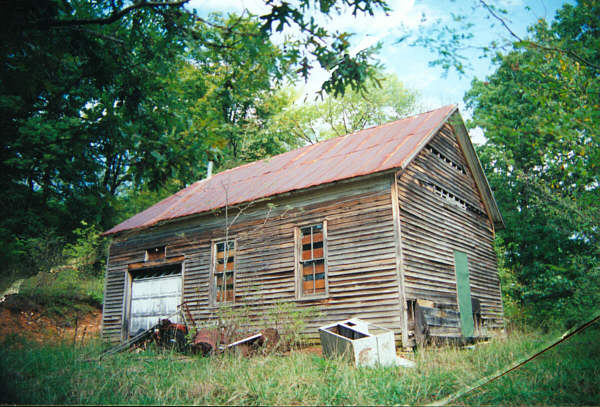
Pleasant Grove Baptist Church
The Pleasant Grove Church came into being as a result of Benjamin Conner, a deeply religious man and a Baptist minister. Around 1909 he felt that God wanted him to build a church house for there were none close by. The people were holding their services in the Pleasant Grove School, which was a small log building. It wasn't large enough for everyone to get in who came to the services. Most everyone he talked to didn't think he could do it, for he was an old man at this time and was recovering from a broken hip. Still he insisted that the Lord wanted him to build a church and that was just what he intended to do.
During the late 1800's Benjamin Conner had been making his living traveling throughout the area on his horse Selim selling books. So, to raise money to build the church he got on his old horse, took all the books he could handle and started on his round selling books and soliciting donations. He took the donations and the profit from the books he had sold and bought the material to build the church house. Other people in the community donated their time for the labor. When the money he had gotten was gone, he would mount Old Selim with his books, make another round and buy more material for the building. He kept doing this until the church was finished.
The building was 24' x 32' with native oak framing, hued logs 7" x 8" for floor sills and pine siding. It was finished on the inside with lath and plaster and a pine floor. It had two rows of benches with an aisle down the middle with some seats placed on each side of the pulpit. Three windows were put on each side of the building with a door in the front nad a door and window in the back of the building. It had two hanging lamps in the middle aisle that would pull down to light then raise back up so people wouldn't hit their heads entering the building and a wall lamp by each window on the side. In the center of the building was a wood stove for heat. IT was a very nice looking building inside and out.
It was named the Pleasant Grove Baptist Church, because it was built near the Pleasant Grove School. But it and the school also became known as The Hog Waller Church and School. It was started by a group of young men from across the river making fun of it. There was a spring branch nearby that had a pool of water in it about waist deep where the preachers did their baptizing. It was good clear water, but down stream from there were some mud holes where the hogs would wallow. So the boys started calling it The Hog Waller Church.
RIVERVIEW BAPTIST CHURCH
At the request of a number of brethren and sisters living in the Horseshoe Bend area, a quorum consisting of Elder E.M. Lumpkins of Spring Garden Baptist Church, Benjamin Conner, Joel Cooper, Jacob Cotton of Blue Springs Baptist Church, A.J. Wood, W.S. Robertson and Elders S.J. adorn and John adorn of New Home Baptist Church, met and organized by appointing Bro. E.M. Lumpkins, chairman and W.S. Robertson, secretary. The council proposed to organize a Baptist Church.
The name chosen by the council was Antioch Baptist Church. The names of the members were listed and two deacons were chosen and were ordained by the council. A Sunday school was organized. Offerings were usually one cent for each member.
On Saturday, August 3, 1902, the Antioch Church convened for worship. After services the church was called into a business meeting session for the purpose of changing the name from Antioch to Riverview. This seemed an appropriate name because of its location. The location was on Horseshoe Bend Road (now HH) about two miles from U.S. Hwy. 54, just across from the cemetery. The site was on the high bluff overlooking the Osage River Valley. In the late 20's and early 30's many of the residents were relocated because of the construction of Bagnell Dam and the valley becoming part of the Lake of the Ozarks. Union Electric offered to buy the land where the church was located. On September 20, 1931, a vote to sell and relocate was defeated. Finally, on April 16, 1932, the congregation voted to sell the church property for $4000.00. A building committee was selected. The present location (2 acres) was purchased for $50.00 per acre. The committee provided plans to build a 32 x 40 foot brick building.
In the period between 1906 and 1930, the church grew in strength and membership. A strong Sunday school was maintained and in the late 20's a BYPU was organized. Between Christmas and New Year was the annual revival time. The song services of this period are worthy of mention. Dillard Moulder taught a series of singing schools during the period, with notable results. Riverview became known as a "Singing Church."
Approximately 253 members were enrolled in Riverview Church prior to the building of Bagnell Dam.
The parsonage was built in 1945. In the late 40's a basement was added to the church and in 1950 an education building was built. The present auditorium and other additions were made in 1964, and the building was completed in November of that year. Additional classrooms and a fellowship hall were added in 1981. Starting in 1993 the church engaged in planning a new building program which will include education space and an auditorium.
Riverview currently has a resident membership of approximately 500, with an average Sunday school attendance of 230. In addition to the regular Sunday schedule of services, Riverview has an RA and GA program, Baptist Women's organization, a music ministry that includes 3 choirs, a bus ministry, and a children's worship ministry.
Since 1932 pastors who have served at Riverview are:
W.W. Bunch, J.W. Jefferies, Robert Sandford, Willard Green, W.L. Long, W.W. Collier, N.E. Williams, W.W. Elliot, O.E. Martin, Jo Cyrus, Johnny Sconce, George E. Cox, Donald Reed, and the present pastor Michael B. Parris.
ROCKY MOUNT BAPTIST CHURCH
When Rocky Mount was a small village with at least one general store, two blacksmiths shops, a drug store and a post office, a group of Christians became concerned about having a Baptist Church in the village.
During March of 1870, under the leadership of J. W. Williams and J. K. Jones a meeting was held at the Cotten School near Rocky Mount for the purpose of establishing a church in the area. J. H. Williams was appointed to make a list of names desiring the formation of a church. The group met in April 1870 at the Liberty Methodist Church for the purpose of being constituted into a church. J.H. Simmons and B. F. Cotten drew up a church covenant, articles of faith and the rules of decorum.
The charter members of Rocky Mount Baptist Church were: T.G McClure, Mary E. McClure, J. H. Simmons, Alcy Simmons, Sarah Ann Simmons, James H. Tindell, Tennessee Tindell, Samuel B. Tindell, and Lawson Thacker.
The newly formed church met at the Cotten and Rocky Mount School houses and at the Liberty Methodist Church. The congregation finally secured an interest in the Liberty building by helping pay for repairs. After the Liberty Church was sold at a public sale the congregation voted to build another building which was completed around 1890 near the present church site. The church began as a member of Concord Association and in August 1893 joined the Miller County Baptist Association.
The early church history indicates that discipline was very strict, not tolerating non-support, drunkenness, immorality, dancing, card playing, cursing, fighting, non-attendance, attending play parties, or other conduct contrary to scripture.
Rocky Mount Baptist Church was known as the United Missionary Church until 1905, at that time it became known as the Rocky Mount Baptist Church.
The first Sunday school for the Union Church was in 1877. Sunday school for the Rocky Mount Church was organized January 12, 1941. The first Vacation Bible School was conducted in 1942 and the following year Training Union was started. WMU began in 1956.
There are many incidents to remember throughout the years. In 1928 Easter Sunday was designated as "Egg Day". The congregation was expected to give the price of the eggs laid that day to the Old Folks Home in Ironton. In 1922 a quilt was made and 10 cents was charged for each name placed on the quilt. The quilt was then sold and the money was used to redecorate the inside of the church building. Electricity became available to the church in 1947 and modern plumbing in 1956. In 1957 live animals were used on the stage in the church for the Christmas play. In 1977 an automobile accident resulted in a car crashing into the basement of the church building.
In 1947 the bell tower of the church was used as a lookout fire tower by the Conservation Department. The bell from the old church is now in the present building and is used weekly for services, and on New Years Eve at Watch Night Services, and various other occasions throughout the year.
The present building was constructed in 1956. Many additions to the building have been made over the year, the latest completed in 1993. In 1972 the church purchased the old Simmons property and furnished a parsonage for the pastor. September 11, 1980 the church borrowed $8000.00 to build a new parsonage.
Over the years the church has had over 40 pastors. The first pastor was Tom Howell, followed by; David McComb, J.E. Simms, J.W. Williams, W.L. Cornett, A.J. Hensley, R.A. Wood, John L. Wood, Willard Brauer, Thomas Bunch (1947), J.L. Mode (1949), Kenneth Carpenter (1958), Selby Graham, C.R. Morgan, Roy Martin and present pastor Dan Duckworth (1979-).
SPRING GARDEN BAPTIST CHURCH
Spring Garden Baptist Church was organized on May 12, 1883, at Locust Mound, Miller County, Missouri. Charter members were: John Lumpkin, J.N. Dooley, Malinda Dooley, Henry Cook, Mrs. Henry Cook, E.M. Lumpkin, Mary Lumpkin, Mattie Lumpkin, J. Ivy Lumpkin, E.B. Lumpkin, Sally Lumpkin, H.L. Moles and L.S. Wadley. The organization was assisted by Rev. N. Allee and W.D. Jordan, E.M. Lumpkin as presbyter, and W. A. J. Farmer (assisting Deacon of Hickory Hill Baptist Church). N. Allee was elected moderator and L.S. Wadley was elected secretary. H.L. Moles, J.N. Dooley and E. M. Lumpkin were appointed to draft the rules of decorum. N. Allee gave the first sermon.
May 14, 1883, the new church met for the second time and elected officers. H.L. Moles was elected trustee and commissioned to find a location for a church house. The church met again on May 17, and H.L. Moles reported the location of a church site in the town of Spring Garden. A committee was appointed to raise money to build a church house. The church would be called the First Baptist Church of Spring Garden.
The new church house was dedicated on Christmas Day in 1883. After the dedication, a three week revival was held, with 31 new members added to the church.
On January 29, 1884, the building committee reported indebtedness on the building of $50.00. It was decided to borrow the money to payoff the bill.
The Miller County Baptist Association annual meeting was held at Spring Garden Baptist Church on August 1, 1884.
During February of 1893, ten years after organization, Spring Garden elected W.W. Sutton pastor, with a salary of $400.00 per year. A revival meeting was started immediately, which lasted until March 13. There were 60 additions to the church: 43 by baptism, 3 by letter, 3 by relation, 4 restored, and 7 on promise of letter. The four that were restored had been members excluded for dancing, drinking and cursing. One-hundred and twenty-one members were added to the church in the first ten years.
In February of 1897, the pastor appointed a committee to devise a plan for repairing the church house. Also during this month, the Lumpkin family was given permission to install the stained glass window in the south end of the church in memory of their father.
The Miller County Baptist Association again held the annual meeting at Spring Garden on September 3, 4, and 5, 1906. People from other parts of Missouri carne by rail on the Rock Island Railroad to Etterville. Local men met them and brought them to the church.
Spring Garden Baptist Church became part of the radio ministry in January of 1953. The pastors of Miller County Baptist Churches and the missionary of the association took turns delivering the message for 15 minutes each weekday morning at 7:45 over KRMS.
After many repairs to the old church house over the years, it was decided that the time had come to construct a new building. Nina Looten donated one acre of land to build the new building. At the homecoming reunion, Sunday, June 8, 1986, it was announced that there was $1,1333.00 in the building fund, and when $3,500.00 was reached that the church would start to build.
After church and a basket dinner March 29, 1987, the land was surveyed and the new building was discussed. It was decided to accept the recommendation for a 50' by 50' building. Money was borrowed from the Citizens Bank of Eldon to buy materials for the building. A gift of $3,700.00 from the Oldham Little Church Foundation of Houston, Texas was received for the building.
The first services in the new church building were held on November 27, 1988. Dedication of the new church building took place on November 12, 1989. At that time $24,484 had been spent on the building, with only $7,580.25 left to pay.
Pastors who served Spring Garden Baptist Church from 1961 to the present time are:
Kenneth Carpenter, John Rollins, Rev. Hufstedler, C.R. Morgan, Louis Elseman, Bill Helvey, James McDonald and Hi Tiffany.
SPRING VALLEY BAPTIST CHURCH
Spring Valley Baptist Church was organized March, 1886, with the following as charter members. W.W. Hoskins, J.B. Hoskins, J.A. Henley, J.B. Henley, A.T. Henley and Henry VanHooser.
The land for the old Spring Valley Church was a gift by S.W. and Minerva Cox and the church was built on the land. In 1960 the property was sold and the church bought the old Spring Valley School house at the corner of Hand BB. The school had two rooms and a full basement and the church was able to move to the new location in 1961.
In 1988 construction started on seven new classrooms, two restrooms and a pastors study with a connecting personal day and sleeping room combined for the pastor and wife. In March of 1927, Spring Valley held a great revival which lasted three weeks. According to records, there were seventy-four people saved and Baptized on March 26, 1927, following the revival. Spring Valley still baptizes in a creek or in a small lake when the weather permits. In 1940 Spring Valley Church had the first Easter Sunrise Service in the area. One of the very first Vacation Bible Schools held in the Miller County Association was held at Spring Valley Church in 1939.
Ministers and missionaries who have been called from Spring Valley Baptist church are:
Wm. Mihfield, D.O. Hickey, Earl Allen, Larry Polly, Cellis Crum, Bill Helvey, Gene Watts, and Robert Hoskins.
Pastors who have served Spring Valley Church:
Earl Allen (1886), A.J. Henley (1907), J.S. Connors (1913-1914), D.M. Williams (1919), T.D. Green, L.E. Maples, J.W. Williams, David McCombs, J.M. Henderson, D.W. Williams, W.L. Houser, Clarence Smith, Carl Porterfield, J.A. Broyles (1924-1926), George Hickey (1930-1932), Virgil Barnard (1934-1938), Lamb James (1939), William Mihfield (1940), Richard Smith (1944), Ted Davis (1948-1949), James Gex (1953), Cellis Crum (1954-1966), Dennis Woolbright (1967), Larry Polly (1970), Tom Siddell (1971), Jim Moad (1973), W.H. Allison (1974), Billy Potter (1975), Bill Helvey (1977-1978), George Cox (1979-1980), Jack Simon (1981), Randy Trumbo (1983-1985), Cellis Crum (1986-).
FIRST BAPTIST CHURCH OF TUSCUMBIA
A small group of Christians met on February 23, 1885 for the purpose of organizing a Baptist Church in Tuscumbia, Missouri. These men were: David McComb, who was elected moderator for the meeting, W.F. Karr, elected Secretary, R.B. Cornett, Z.T. McCubbin and J. F. Got t. The following were presented as charter members: Meria Bacon, Alice Burris, C. A. Burris, Fannie Burris, Martha Burris, W. M. Burris, Irene Cox, Lena Fisher, Bird Kelsay, Rosa Kelsay, Calodona Lawson, Nancy Lawson, Ellen Matthews, Albert McCubbin, Minnie Starling, Fannie Williams and Henry Williams.
At the regular business meeting August 10, 1895, the Church voted to send delegates to the Miller County Association of Baptist Churches, and to send a letter requesting admission into the Association.
In November 1895 a site was chosen for the first church house. A lot was selected in Clark Addition where the church was built and was dedicated on Sunday, October 10, 1897. The church was erected at a cost of $1,205.00 of which $1,140.00 had been paid.
On December 5, 1956 a committee was appointed to purchase lots for a new building site. Four lots on highway 52, opposite the town cemetery, were recommended and purchased. The first revival in the new church house was conducted in July of 1960. During the summer and fall of 1975 an addition was built on the church to serve as Sunday school rooms. Burning of the note for the main church building and the ceremony of ground breaking for the new Sunday school rooms took place at the same time. In the fall of 1976 the balance of the note was paid for the Sunday school rooms and some additional lots were purchased.
Lay members Alva and Ruby Vaughan volunteered to serve as missionaries in Africa. They left in December 1979 and served for 16 months in Kenya.
The following served as pastors at First Baptist Church of Tuscumbia:
R.B. Cornett (1895), W.W. Cornett (1985), Chester Lindsey (1941-1942), Frank Chase (1942-1945), J.D. Gilliam (1945), C. W. Turner (1946-1949), McCoy (1949-1950), Robert Todd (19521956), LeRoy Tolliver (1956-1957), George Huffman (1958-1960), Lon Brown (1961-1962), Robert Steveson (1962-1965, Berman Grant (19651968), Claude Stevens (1969-1971), Tom Schauffler (1972-1973), Russell Hyatt (1973-1975), Ted Stone (1976), Robert Edwards (19761977), George Cox (1978-1982), Tom Nelson (1982, interim), Harold Williams (1882-1985), Tom Nelson (1982, interim), Robert Nuckolls 1986-1988}, Wes Herwick (1988-1990), Don Bilbary Jr. (1990-present)
ULMAN BAPTIST CHURCH
Ulman Baptist Church was organized August 13, 1897. The organizers were: W.H. Payne, R.B. Cornett, E.M. Lumbkin, George Woolsey, and Jesse Gott.
On August 14, 1897 a church building site and property deed was obtained. At this time there were twenty charter members. A meeting room was rented from Ernest Clark, the local hotel owner, for the sum of one dollar per month.
A business meeting was held September 30, 1897 and Ed Clark was hired to build a church house of the sum of six hundred dollars. An offering was taken at this time and the sum of $120.00 was raised for the new church house.
The church building was completed and dedicated on May 26, 1901. The furnishings for the church consisted of pews, chairs and carpet cost $ 123.91. An organ was purchased February 1902 for $39.10. A belfry was completed in December 1903, and a sexton elected to take care of the ringing of the bell.
August 30, 1911, a revival meeting was started that lasted for twenty-five days. It was conducted by J. M. Bandy and Albert Sutton. This revival resulted in 82 additions to the church, many by baptism, and some by transfer and statement.
Within the early established church there was a practicing committee on discipline Sometimes the hand of fellowship was withdrawn from some members for the following offenses: drunkenness, dancing, profanity, and covetousness. In order for a member to regain full fellowship, he had to ask for forgiveness and the church voted to either re-instate or reject his request. This action was sometimes referred to as "churching a member." This practice is very seldom carried out in the church today, although it is still provided for in the church constitution.
Early pastors were elected on a yearly basis and their salaries voted on and approved each year. Many were hired on a quarterly or half-time basis. Recent pastors have been bi-vocational, requiring them to work at a job as well as pastor the church, with services held each week. At the regular business meeting, February 6, 1966, a discussion was held about remodeling the old church or trying to locate a new building site and build a new church. It was decided it would be more logical to build a new building, since the original site had no space for parking cars, no well or classrooms.
On March 26, 1967 a new site was selected and acquired. A set of church building plans was ordered from the Missouri Baptist Building Fund on February of 1968. The construction began in May 1968 and the congregation moved into the new building in October 1968. The money required to build the new church was largely borrowed form the Missouri Baptist Building Fund, on a fifteen year loan. The loan was paid off with a note burning ceremony in April 1983. The church was dedicated July 27, 1969.
The flat roof on the fellowship room was replaced by a gable roof in 1984. The most recent improvements to this area have been laying new carpet, enlarging kitchen area, installing new cabinets, sink, stove, microwave, refrigerator, and serving cabinets.
The following pastors have been licensed and ordained to preach by the Ulman Baptist Church: Simon Cox, ordained in 1911 and Mark Kessler, ordained in 1984.
Pastors who have served Ulman Baptist Church:
E.M. Lumpkin (1897-1904), R. B. Cornett (1904-1905), E.M. Lumpkin (1905-1906), W.E. Scrivner (1906-1908), E.M. Lumpkin (1908), Albert Siton (19081909), S.J. Neal (1909), E.M. Lumpkin (1909-1910), J.M. Bandy (1910-1913), W.E. Self (1913-1914), S.P. Cox (1914-1916), J.S. Conner (1916-1919), W.S.Berge (1919-1920), Sylvires (1920) interim, W.S. Berge, (1920-1923), T.F. Simmons (1923), W. Mustain (1923- 1924), S.P. Cox (1924-1927), C.D. Manes (1927), D.S. Scrivner (1927-1928), W.H. Zumwart (1928-1930), W.W. Bunch (1930-1932), G.O. Hickey (1932-1933), G.O. Hickey (1941-1942), Gebhart (1942-1946), Howard Karr (1946-1948), Merle Bandy (1948-1953), F.M. Maness (1953-1954), Charles Cox (1958), Gerald Harrison (1958), Tommy Bunch (1959-1961), Louis EIseman (1961-1962), Charles Cox (19621963) interm, Kenneth Gray (1964-1967), Donald Gardner (1968-1970), Charles Cox (1970-1977), Eldon Myers (1977-1980), Billy Helvey (1981-1982), Greg Huddleston (1982-1984), Mark Kessler (1984-).
Rev. Tom Abbott is currently the pastor and Bud Dilley, Sunday school Superintendent.
UNITED BAPTIST CHURCH OF CHRIST IN THE BIG RICHWOODS
By Peggy Smith Hake
The United Baptist Church of Christ in the Big Richwoods was organized as early as 1843, but it was not until the 6th of March, 1858, they were conveyed an acre of land on which to build their church house. Samuel P. and Melvina Tucker donated this one-acre plot of ground to the Trustees of the church. The five trustees named in 1858 were Reuben Short, James Bowlin, Pauling Gardner (my great, great grandfather), Alvis Dunkin/Duncan, and William R. Right/Wright. In the deed, it states that the Tuckers in "Christian benevolence and good will" donated this one acre of land to the United Baptist Church Church of Christ for a "public place of worship and a cemetery for the use and benefit of the neighborhood".
Sometime prior to December 1840, a man named Creed T. Biggers entered this 40-acre tract of land and he patented the land in 1840. He kept it for only a short time and sold it to Oby D./Obadiah and Caroline Dyer. The Dyers were in possession of the acreage for 13 years when they sold it to William and Louisa Burks. In 1857, the Burk's sold 28 acres east of the branch that ran through the plot to Samuel and Mary Melvina Tucker. The small branch was a tributary of the Rabbit Head Creek, which ran in a northeasterly direction. The following year, 1858, Samuel and Mary Tucker donated a one-acre parcel to the Trustees of the United Baptist Church.
A small church was built on this one-acre plot near the burial site of Elijah Dyer, son of Haman and Frances Dyer, born in Virginia in 1786. Elijah was buried there on 27 November 1841. He was one of the early pioneer homesteaders in the Iberia area for he had entered and patented 40 acres of land, about one-half mile west of this cemetery, in 1838.
Today, part of his original land is included in the northeastern portion of Iberia's city limits. The grave remains on the same site today and can be found approximately 100 feet south of the South wall of the Iberia City Cemetery. The church was still on the same site in the 1880s and the cemetery at that time was referred to as the "Sulkey Cemetery". My great, great grandfather, Pauling Gardner, one of the original trustees, was buried there in 1886 and in his burial records I found the name of the cemetery recorded as "Sulkey Cemetery".
NOTE: I have heard the legend that the church and cemetery were called 'Sulkey' because of the attitude some of the members had toward one another. That would probably be another interesting story if the proof could be found!

|
P.O. Box 57 Tuscumbia, MO 65082 http://www.MillerCountyMuseum.org © 2007 - Miller County Historical Society millercountymuseum@att.net |

|
